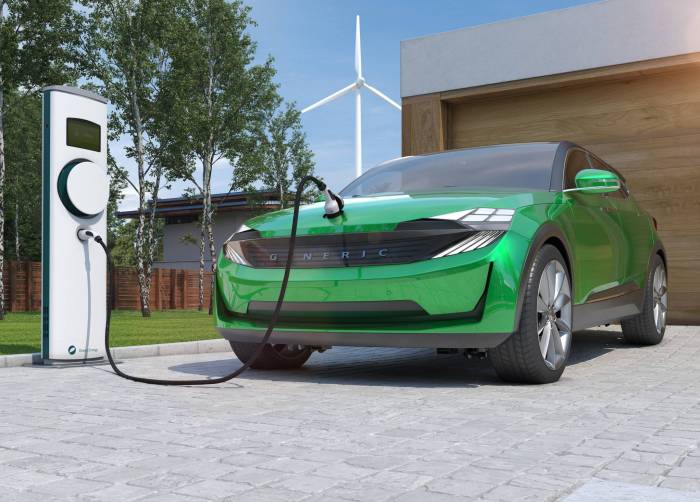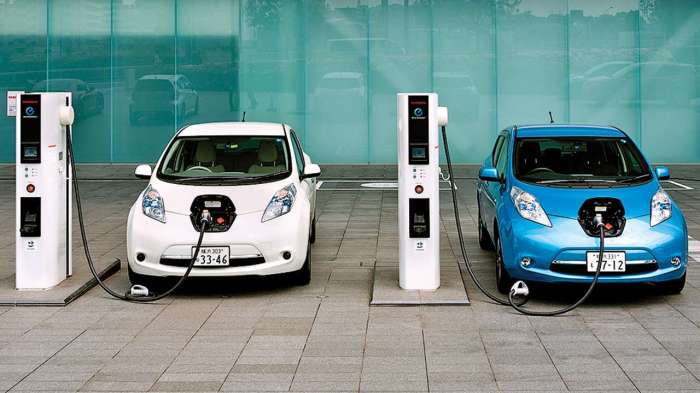Electric vehicles are revolutionizing the way we commute, offering a cleaner and more eco-friendly alternative to traditional gas-guzzlers. Buckle up as we dive into the world of electric vehicles, exploring their benefits, types, and future trends.
Overview of Electric Vehicles
Electric vehicles, also known as EVs, are automobiles powered by electricity stored in batteries, rather than relying on gasoline or diesel fuel like traditional vehicles. This shift in power source marks a significant departure from the internal combustion engine technology that has dominated the automotive industry for decades.
Electric vehicles offer numerous environmental benefits compared to their gasoline-powered counterparts. They produce zero tailpipe emissions, reducing air pollution and greenhouse gas emissions that contribute to climate change. Additionally, EVs are more energy-efficient, as electric motors are typically more efficient than internal combustion engines in converting energy into motion.
The growth and popularity of electric vehicles have been steadily increasing in the automotive industry. Advancements in battery technology have extended the driving range of EVs, alleviating range anxiety among consumers. Government incentives and regulations promoting clean transportation have also fueled the adoption of electric vehicles worldwide, leading to an expanding market for EV manufacturers.
Types of Electric Vehicles
Electric vehicles come in various types, each with its own unique features and benefits. Let’s take a closer look at the different categories available in the market today.
Battery Electric Vehicles (BEVs)
Battery electric vehicles, or BEVs, are fully electric vehicles that run solely on electric power stored in rechargeable batteries. These vehicles do not produce any tailpipe emissions, making them environmentally friendly. Popular examples of BEVs include the Tesla Model 3, Nissan Leaf, and Chevrolet Bolt EV.
Plug-in Hybrid Electric Vehicles (PHEVs)
Plug-in hybrid electric vehicles, or PHEVs, combine an internal combustion engine with an electric motor and a rechargeable battery. These vehicles can operate in all-electric mode for shorter trips and switch to the internal combustion engine for longer journeys. Examples of PHEVs include the Toyota Prius Prime, BMW X5 xDrive45e, and Mitsubishi Outlander PHEV.
Fuel Cell Electric Vehicles (FCEVs)
Fuel cell electric vehicles, or FCEVs, use hydrogen gas to generate electricity through a chemical reaction in the fuel cell stack. These vehicles emit only water vapor as a byproduct, making them a clean alternative to traditional gasoline-powered cars. Popular FCEVs include the Toyota Mirai, Honda Clarity Fuel Cell, and Hyundai Nexo.
Charging Infrastructure: Electric Vehicles
Electric vehicles rely heavily on charging infrastructure to support their operation and promote widespread adoption. Without a robust network of charging stations, EV owners may face challenges in finding convenient and accessible places to recharge their vehicles. Therefore, the development of charging infrastructure is crucial for the success of electric vehicles in the transportation sector.
Types of Charging Stations
- Level 1 Charging: This type of charging station is the most basic and typically uses a standard 120-volt outlet. While convenient for home charging, it can be slow and may not be suitable for long-distance travel.
- Level 2 Charging: Level 2 stations provide faster charging than Level 1, using a 240-volt outlet. These stations are commonly found in public locations such as shopping centers, workplaces, and parking garages.
- DC Fast Charging: DC fast charging stations offer the quickest charging speeds, allowing EV drivers to recharge their vehicles in a matter of minutes. These stations are essential for long-distance travel and are typically located along highways and major routes.
Challenges and Advancements
- Challenges: One of the main challenges in charging infrastructure is the need for standardization and interoperability among different charging networks. This ensures that EV owners can easily access charging stations regardless of the brand or model of their vehicle. Additionally, the limited availability of fast-charging stations in certain regions can hinder the widespread adoption of electric vehicles.
- Advancements: The advancement of technology has led to improvements in charging speed, efficiency, and convenience. Innovations such as smart charging solutions, bi-directional charging capabilities, and wireless charging systems are shaping the future of EV charging infrastructure. These advancements aim to make charging more seamless and user-friendly for EV owners.
Range and Battery Technology
Electric vehicle range is influenced by various factors, including battery capacity, driving conditions, speed, and climate. As battery technology improves, the range of electric vehicles continues to increase, making them more practical for everyday use.
Factors Influencing Range
- Battery capacity: The size and energy density of the battery pack directly affect the range of an electric vehicle.
- Driving conditions: Stop-and-go traffic, highway driving, and hilly terrain can impact the efficiency of an electric vehicle and reduce its range.
- Speed: Higher speeds require more energy, which can decrease the overall range of an electric vehicle.
- Climate: Extreme temperatures, especially cold weather, can reduce battery performance and limit the range of an electric vehicle.
Advancements in Battery Technology
- Lithium-ion batteries: Widely used in electric vehicles due to their high energy density and long lifespan. They are lightweight and offer good performance.
- Solid-state batteries: Considered the next generation of battery technology for electric vehicles, offering higher energy density, faster charging times, and improved safety.
- Other emerging technologies: Researchers are exploring new battery chemistries, such as lithium-sulfur and lithium-air, to further improve the range and performance of electric vehicles.
Government Incentives and Policies

Government incentives and policies play a crucial role in promoting the adoption of electric vehicles. These measures aim to make EVs more affordable, increase charging infrastructure, and reduce carbon emissions in the transportation sector.
Successful Electric Vehicle Incentive Programs
- Norway: Norway offers various incentives such as tax exemptions, reduced parking fees, and access to bus lanes for EV owners. As a result, Norway has one of the highest EV adoption rates globally.
- United States: The federal government offers a $7,500 tax credit for EV buyers, along with various state-level incentives such as rebates, carpool lane access, and free charging stations.
- China: China has implemented a comprehensive set of incentives, including purchase subsidies, license plate lotteries, and exemptions from certain driving restrictions in congested cities.
Impact of Regulations on Electric Vehicle Market Growth
- Regulations mandating automakers to produce a certain percentage of zero-emission vehicles have pushed companies to invest more in EV technology and production.
- Emission standards and carbon pricing policies have incentivized consumers to choose cleaner alternatives like electric vehicles over traditional gasoline cars.
- The establishment of charging infrastructure standards and requirements has accelerated the deployment of EV chargers, making it more convenient for consumers to switch to electric vehicles.
Future Trends in Electric Vehicles

Electric vehicles are constantly evolving, and the future holds exciting possibilities for this industry. From advancements in technology to innovative design solutions, the future of electric vehicles is promising.
Advancements in Battery Technology
With ongoing research and development, the future of electric vehicle battery technology looks bright. Manufacturers are working on improving energy density, reducing charging times, and increasing overall battery lifespan. These advancements will lead to longer driving ranges and faster charging times for electric vehicles.
Autonomous Driving Features
Autonomous driving features are expected to become more prevalent in electric vehicles in the future. With advancements in artificial intelligence and sensor technology, self-driving capabilities will enhance the overall driving experience while increasing safety on the roads. These features will revolutionize the way we interact with our vehicles and navigate our daily commutes.
Vehicle-to-Grid Technology
Vehicle-to-Grid technology allows electric vehicles to not only consume energy but also to give back to the grid when needed. This innovative concept enables electric vehicles to store excess energy and then supply it back to the grid during peak demand periods. As this technology continues to develop, it will play a crucial role in balancing energy supply and demand, making electric vehicles an essential part of the future energy ecosystem.
Wireless Charging Solutions
Wireless charging is another exciting trend in electric vehicles. This technology eliminates the need for cables and connectors, making the charging process more convenient and user-friendly. As wireless charging infrastructure becomes more widespread, electric vehicle owners will enjoy a seamless charging experience without the hassle of plugging in their vehicles.
Sustainable Materials and Design
In the future, electric vehicles are expected to incorporate more sustainable materials and eco-friendly design solutions. From recycled plastics to biodegradable components, manufacturers are exploring innovative ways to reduce the environmental impact of vehicle production. These sustainable practices will not only benefit the planet but also attract environmentally conscious consumers to the electric vehicle market.
